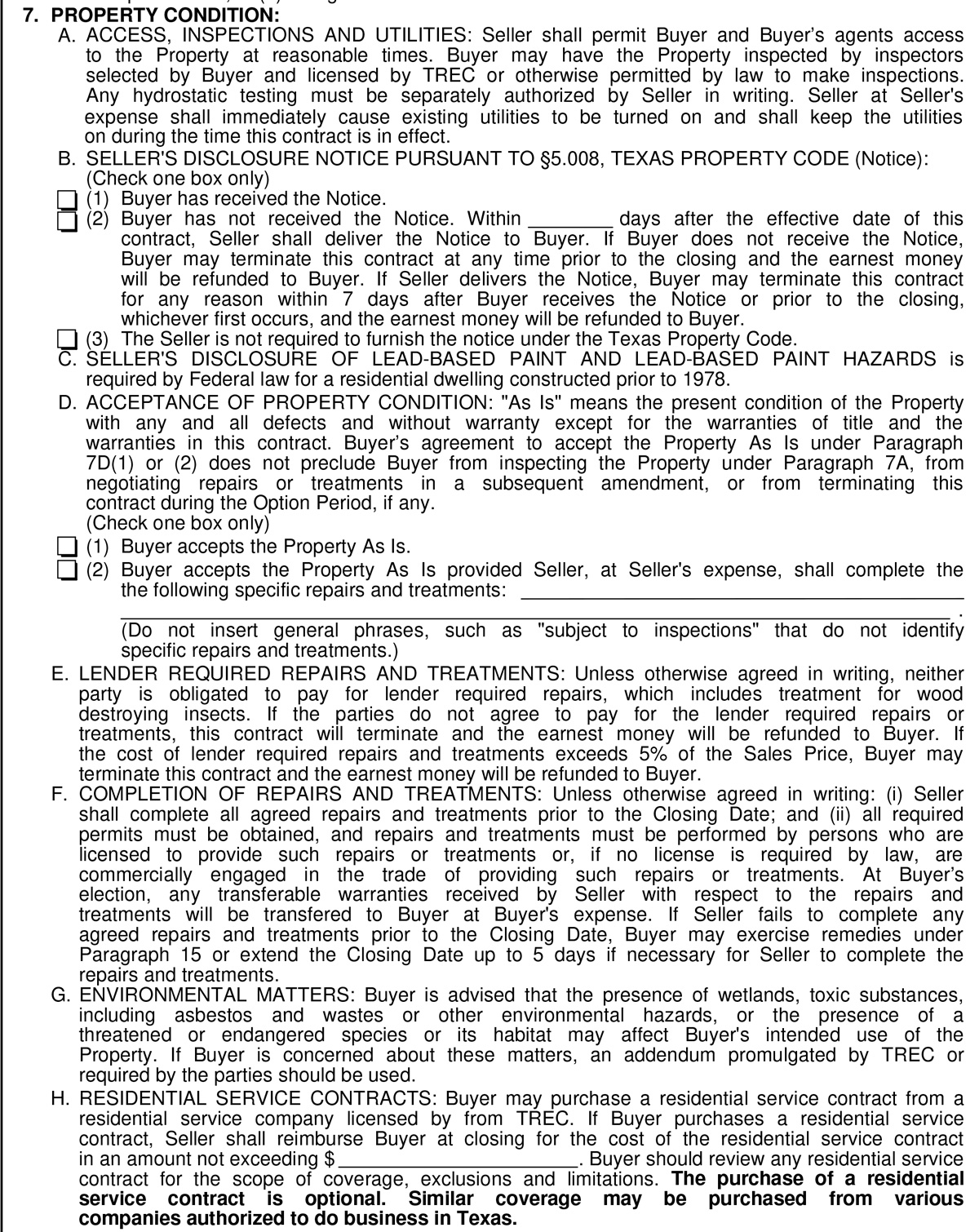Note: The Texas Association of Realtors and TREC update promulgated forms regularly. For the most recent updates, check with TAR, TREC, or contact me at brian@starpointerealty.com.
Note: I am a real estate professional, not a lawyer. Nothing herein should be construed as legal advice or instructions.
Previously was Paragraph 6 – Title Policy and Survey.
Paragraph 7.A. Access, Inspection and Utilities. THE SELLER MUST HAVE THE UTILITIES ON DURING THE ENTIRE CONTRACT PERIOD! At their own expense. And this is the paragraph that says exactly that. Generally, I recommend sellers leave the utilities on during the entire time a home is on the market because A) having a pleasant, air conditioned home will make buyers feel nice when viewing and B) You’ll have to turn them back on anyway!
Also this paragraph requires that the seller permit the buyer to access the property to conduct necessary inspections with licensed inspectors, and not just during the option period (general inspections, pool, pest, well, septic, roof … there are a lot of potential inspectors a buyer would be advised to pay for, depending on the property!)
Paragraph 7. B. Seller’s Disclosure. In most cases, the Seller is legally obligated to provide the buyer with a Seller’s disclosure which lists any issues about the property of which the seller is aware. Often, the listing agent will have the disclosure immediately filled out and available on the MLS for the buyer’s agent. If not, you can check box 2 and specify when they would like the disclosure by (I often put 5 days). If box 2 is checked, this is another rare but possible “out” the buyer has from the contract if the seller and their agent are not prompt.
The disclosure is not required in the case of foreclosures or multi-family units, like duplexes and fourplexes (so box 3 should be checked).
Paragraph 7.C. Lead Based Paint Disclosure. In addition to the general disclosure discussed above, this two page additional disclosure must be attached, filled out by the seller, if the home was built prior to 1978.
Paragraph 7.D. Acceptance of Property Condition.
“I’m buying it as-is? What if we discover a problem???”
The paragraph can cause some momentary confusion. Often you will be accepting the property “as-is”, understanding that you will later (Pargraph 23: Termination Option) have the option to renegotiate repairs during any option period to which you and the seller agree in Paragraph 23.
Example: You, the buyer, accept the property “as-is” (Box 1) but also ask for a 14 day option period in Paragraph 23 for an option fee of $50. The seller agrees and you have a contract! You inspect the property on Day #5 of your 14 day option period and the inspector discovers that the roof has hail damage. You submit an amendment to the contract asking the seller to pay for the repair. The seller does not have to, and you both negotiate – your leverage as the buyer is that you are still in the option period and can walk away from the deal if the seller does not come to terms.
If you already know of a specific repair or treatment you would like done, you can check box 2 and specify it up front.
Paragraph 7.E. Lender Required Repairs. The buyer may not ask for any repairs, but instead their lender require it. Depending on the lender and the type of financing (VA and FHA are the most strict), lenders require the property to meet minimum standards. These required repairs may not be known until after the appraisal, which often is very late in the process. The seller is NOT required to pay for any of these repairs until agreed to in writing. So discovering a lender required repair reopens the negotiations.
As long as the repair is less than 5% of the price, and the seller is willing to make the repair or come to terms with the buyer, then the buyer cannot use the repair as an excuse to get out of the contract.
Paragraph 7.F. Completion of Repairs and Treatments. THE REPAIRS NEED TO BE COMPLETE BY CLOSING! There are some workarounds to this rule, like setting up an escrow from the seller to cover certain repairs after the closing, but generally speaking you are going to be buying the house however it is on closing day. Even if you have a separate repair agreement in writing with the seller, there is no guarantee anything will be done after closing. So as painful as it can be to delay closing, or even terminate a contract because of repairs left undone, be aware that you are accepting the house as-is if you choose to close with incomplete repairs. It also behooves the seller to be prompt completing repairs, because incomplete repairs can delay closing or even allow the buyer to walk away.
Paragraph 7.F. Residential Service Contracts.
Also called a home warranty, a residential service contract further protects the buyers against unforeseen problems with the home. A buyer can buy a residential service contract on their own, or can ask the seller to help pay for the first year of a contract, after which the buyer/owner would continue paying for it themselves if they like.
Elsewhere I talk a lot more about residential service contracts and some of the companies we recommend, but just know that this is the paragraph where you can request the seller to contribute toward the first year of a contract as a seller concession. In hot seller’s markets, fuhgeddaboudit. In buyers markets and 2015 Fort Hood area, it is a common seller concession to the buyer to contribute $450 or so toward the buyer’s residential service contract.
Next time we will be on to Paragraph 8: Brokers’ Fees, a tiny little paragraph during which discussion we will also review some separate forms as well.
Questions about As-Is, Inspections or Home Warranties? Please post them in the comments below for everyone to see!


